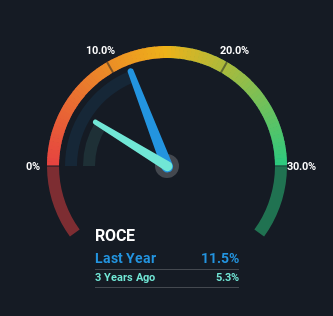- Hong Kong
- /
- Construction
- /
- SEHK:1627
Capital Allocation Trends At Able Engineering Holdings (HKG:1627) Aren't Ideal
If we want to find a stock that could multiply over the long term, what are the underlying trends we should look for? Typically, we'll want to notice a trend of growing return on capital employed (ROCE) and alongside that, an expanding base of capital employed. Put simply, these types of businesses are compounding machines, meaning they are continually reinvesting their earnings at ever-higher rates of return. Although, when we looked at Able Engineering Holdings (HKG:1627), it didn't seem to tick all of these boxes.
Return On Capital Employed (ROCE): What Is It?
Just to clarify if you're unsure, ROCE is a metric for evaluating how much pre-tax income (in percentage terms) a company earns on the capital invested in its business. To calculate this metric for Able Engineering Holdings, this is the formula:
Return on Capital Employed = Earnings Before Interest and Tax (EBIT) ÷ (Total Assets - Current Liabilities)
0.12 = HK$231m ÷ (HK$4.6b - HK$2.6b) (Based on the trailing twelve months to March 2023).
So, Able Engineering Holdings has an ROCE of 12%. In absolute terms, that's a satisfactory return, but compared to the Construction industry average of 6.5% it's much better.
View our latest analysis for Able Engineering Holdings

While the past is not representative of the future, it can be helpful to know how a company has performed historically, which is why we have this chart above. If you'd like to look at how Able Engineering Holdings has performed in the past in other metrics, you can view this free graph of past earnings, revenue and cash flow.
So How Is Able Engineering Holdings' ROCE Trending?
In terms of Able Engineering Holdings' historical ROCE movements, the trend isn't fantastic. Over the last five years, returns on capital have decreased to 12% from 17% five years ago. However it looks like Able Engineering Holdings might be reinvesting for long term growth because while capital employed has increased, the company's sales haven't changed much in the last 12 months. It's worth keeping an eye on the company's earnings from here on to see if these investments do end up contributing to the bottom line.
On a side note, Able Engineering Holdings' current liabilities have increased over the last five years to 57% of total assets, effectively distorting the ROCE to some degree. Without this increase, it's likely that ROCE would be even lower than 12%. And with current liabilities at these levels, suppliers or short-term creditors are effectively funding a large part of the business, which can introduce some risks.
Our Take On Able Engineering Holdings' ROCE
In summary, Able Engineering Holdings is reinvesting funds back into the business for growth but unfortunately it looks like sales haven't increased much just yet. Unsurprisingly, the stock has only gained 17% over the last five years, which potentially indicates that investors are accounting for this going forward. Therefore, if you're looking for a multi-bagger, we'd propose looking at other options.
Since virtually every company faces some risks, it's worth knowing what they are, and we've spotted 2 warning signs for Able Engineering Holdings (of which 1 is potentially serious!) that you should know about.
While Able Engineering Holdings isn't earning the highest return, check out this free list of companies that are earning high returns on equity with solid balance sheets.
New: Manage All Your Stock Portfolios in One Place
We've created the ultimate portfolio companion for stock investors, and it's free.
• Connect an unlimited number of Portfolios and see your total in one currency
• Be alerted to new Warning Signs or Risks via email or mobile
• Track the Fair Value of your stocks
Have feedback on this article? Concerned about the content? Get in touch with us directly. Alternatively, email editorial-team (at) simplywallst.com.
This article by Simply Wall St is general in nature. We provide commentary based on historical data and analyst forecasts only using an unbiased methodology and our articles are not intended to be financial advice. It does not constitute a recommendation to buy or sell any stock, and does not take account of your objectives, or your financial situation. We aim to bring you long-term focused analysis driven by fundamental data. Note that our analysis may not factor in the latest price-sensitive company announcements or qualitative material. Simply Wall St has no position in any stocks mentioned.
About SEHK:1627
Able Engineering Holdings
Engages in the building construction business in Hong Kong.
Excellent balance sheet and fair value.
Market Insights
Community Narratives


Recently Updated Narratives

Bisalloy Steel Group will shine with a projected profit margin increase of 12.8%

Astor Enerji will surge with a fair value of $140.43 in the next 3 years

Proximus: The State-Backed Backup Plan with 7% Gross Yield and 15% Currency Upside.
Popular Narratives


MicroVision will explode future revenue by 380.37% with a vision towards success


NVDA: Expanding AI Demand Will Drive Major Data Center Investments Through 2026



